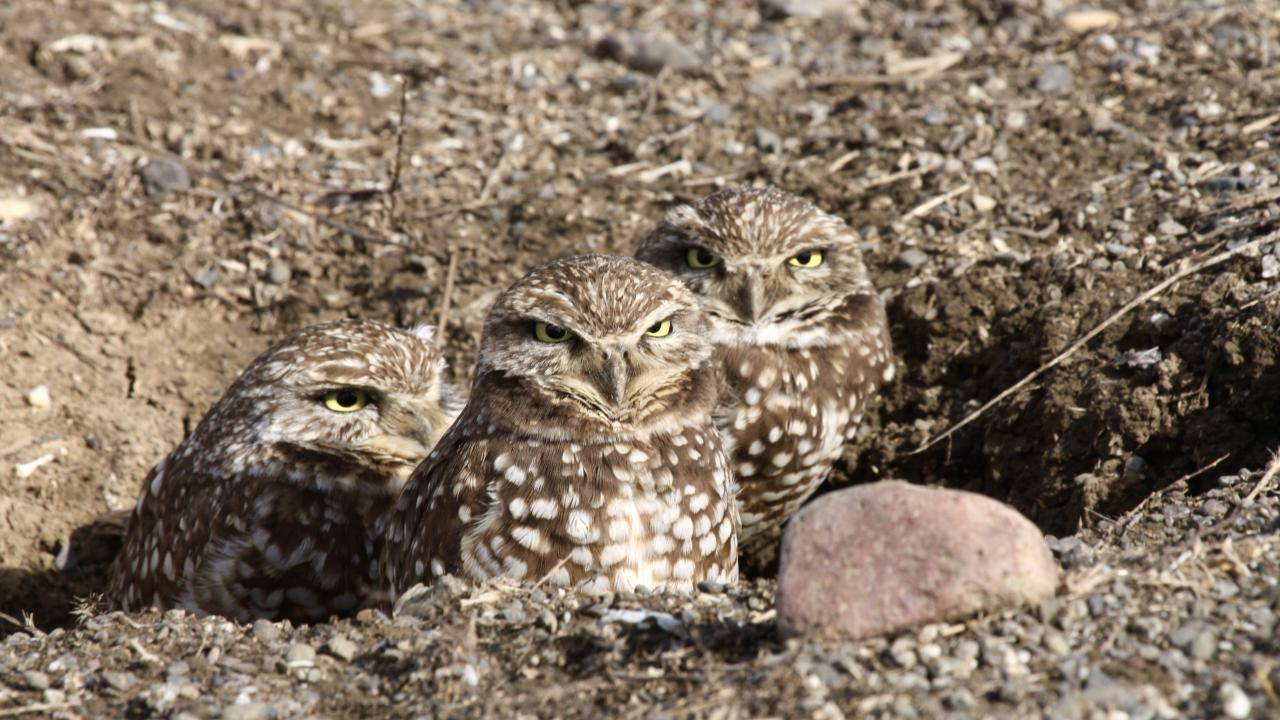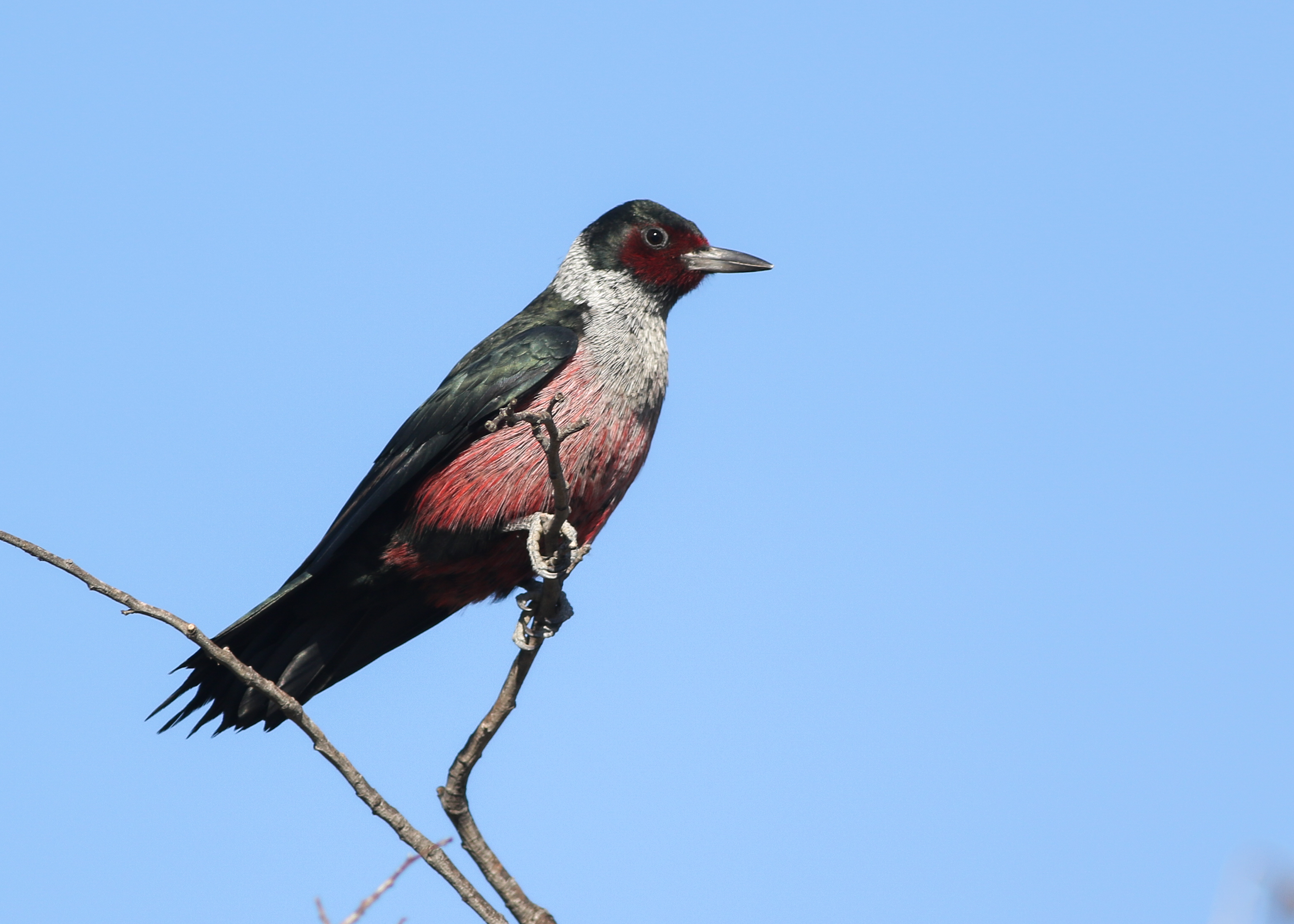
UC Davis Team Breaks ‘Big Day’ County Record with 173 Birds
The 24-hour Birding Challenge Covers Yolo County’s Diverse Habitats
The wind was whipping across a dark, open field near the southern edge of Yolo County when two small burrowing owls suddenly burst into flight. For a team of birders from UC Davis, the birds marked the 173rd species of the day, breaking a county record that had stood for 25 years.
It was the exciting conclusion of their “Big Day,” a fast-paced birding challenge to find and identify as many bird species as possible in a 24-hour period. Their effort – spanning 150 miles of driving, 17 miles of walking and 41 stops – combined careful planning with a love of birds.
The team was made up of four birders from the Department of Wildlife, Fish and Conservation Biology: Associate Professor Daniel Karp, Assistant Professor of Teaching Robert Furrow, Assistant Project Scientist Jason Riggio and undergraduate student Zane Pickus.
They had been preparing for weeks by scouting locations, checking recent sightings on eBird.org (website by Cornell University Lab of Ornithology) and packing their “superstitious snacks” for the road. Karp swears by Cheez-Its. Furrow brings Funyuns. Riggio had his Fig Newtons, and Pickus brought Wheat Thins.
“You have to be kind of intense to do this,” Karp said. “There are very few people that would want to be on their feet for 22 hours, doing nothing but looking for and talking about birds; even when we were driving, we were completely focused on birds.”
Early to rise

A sunrise view from the top of Rayhouse Road in Capay Valley. This is where the team saw and heard several migratory birds. Photo by: Zane Pickus, UC Davis.
Their journey started at 1:30 a.m. on May 1 in wetland and grassland patches near Davis. They planned the day down to the minute and strategized to find some nocturnal species at the very beginning. The American barn owl called in the dark and marked the first bird of the day. It was soon followed by the chatters, whistles and grunts of the marsh wren, tricolored blackbird and American bittern.
They spotted a flying lesser nighthawk at a stop in Capay Valley before beginning a four-mile, pre-dawn hike up Rayhouse Road in Cache Creek Regional Park. Great horned owls called from the lower section, and they heard a western screech owl too.
“It was two or three in the morning when we began hiking 2,000 feet of elevation in the dark, encountering some foxes, newts and owls around us as we were trying to get to the top,” Karp said.
They aimed to reach the top by dawn to catch a wave of migratory birds that would pass over the chaparral habitat just as the sun hit the eastern-facing slopes. They heard mountain quail, rufous-crowned sparrow, lark sparrow, California thrasher and blue-gray gnatcatcher.
“As the sun started to come over the hill, birds started to migrate and we could see them flying past us,” Pickus said. “I think we probably had 20 or something migratory species that we didn't have anywhere else that day. Colorful birds that are arriving from the neotropics that come up here in the spring.”
Ducks, shorebirds and hawks

The birders were pleasantly surprised to find this species, a Lewis’s woodpecker, at one of their stops in the Capay Valley. Photo by: Zane Pickus, UC Davis
By late morning, fatigue was setting in. Some of the guys took a “micronap” in between stops for a burst of energy. The team stopped at the Woodland wastewater treatment facility, a sprawling network of ponds near Costco known to harbor several duck and shorebird species. It didn’t disappoint. Within minutes, they had spotted northern pintail, common goldeneye, ring-necked ducks and a pair of greater white-fronted geese among other birds.
“We picked up a lot of new birds there,” said Pickus. “There was a really beautiful horned grebe, which you don't usually see at this time of year in this area, so that was nice. We had seen that in the days leading up to our Big Day but were very grateful that it stuck around an extra day.”
In the late afternoon, the team headed toward the Yolo Bypass, re-invigorated but also having doubts they'd reach the record of 172 species set in 2000.
“On the way to the bypass, Rob's driving, Danny is navigating, Zane and I are in the backseat listing out what we’ve seen and what we need to see,” Riggio explained. “We were thinking we were probably going to be at least 10-15 species off from the record. Maybe if everything went right for us, we thought we might see 10 new birds in the bypass.”
Excitement at the Yolo Bypass

The whole team was excited to see a northern pygmy owl, like the one seen here, on their Big Day in Yolo County. Photo by: Zane Pickus, UC Davis
Around 4 p.m., they entered the Yolo Bypass Wildlife Area and everything changed. They quickly began checking off much-needed species: yellowlegs, larks, pheasants, black-bellied plovers and a solitary sandpiper that surprised them.
“The sandpiper at the bypass was definitely a highlight for me,” Pickus said. “They're pretty uncommon around here and you're lucky to see maybe one or two per year if you're getting out a lot. So, the fact that we connected with one on our Big Day was definitely special.”
They scoped distant ospreys and white-tailed kites. The team also spotted a peregrine falcon jetting off to hunt some shorebirds. Now the adrenaline was flowing. The record had seemed out of reach, right up until this successful stop.
“Everything seemed possible again,” Riggio said. By the time they left the area, their total number of species had surged.
“We'd been working really hard all day, but by the end there was like five targets left, so it's like, ‘Okay, we have to spend the next three hours shaking every bush, running down every field to try to find five more species,’ and that's basically how it went down,” Furrow said.
The final sprint

The team heard a least bittern, like the one seen here, on their Big Day. It was species number 172 and tied the record around 9 p.m. Photo by: Zane Pickus, UC Davis.
Following the Yolo Bypass, they checked out Bridgeway Island Pond in West Sacramento that attracts a particular species of duck, the blue-winged teal, which Furrow said is very uncommon anywhere in the county, except on this pond. It was there. The teal ended up being the last duck they found that day.
Then they visited a private residence near Clarksburg known for its rare hummingbird sightings. They witnessed two crucial birds: the relatively common black-chinned hummingbird and the rarely seen Allen’s hummingbird, a coastal species that is scarce this far inland.
With 171 birds tallied at this point in the night, the team was just one shy of tying the Yolo County record. To reach 172, they followed up on a recent report of a least bittern in West Sacramento. This bird is elusive and sings only occasionally at night.
“Rob heard it first,” said Karp. “Then I heard it. Then Zane. We waited and waited for Jay to hear it because we couldn’t move on without confirming it as a group. Finally, he caught the sound. That tied the record.”
Breaking the record
With tired eyes and high spirits, the team made the long drive to the dark, windswept fields of southern Yolo County in search of one last bird – the burrowing owl.
“It’s dark. It’s late. The wind is whipping. It’s very cold,” Karp said. “We’re sort of whistling and walking around and we don't see it. We're starting to get worried. And then two of them fly right in front of us, and that is our 173rd bird.”
They tried to push for one final species, a grasshopper sparrow, but the cold and wind were too much. No luck. They decided to end with a total of 173 species and headed home around 11 p.m.
“I was really excited,” Pickus said. “I really didn't think we had any shot of breaking the record. I've known about this record since I started birding. It really felt kind of impossible in a lot of ways.”
Lifelong birders have unforgettable day

(L-R) Rob Furrow, Jason Riggio and Daniel Karp at the end of a previous Big Day in Solano County in 2023. Photo by: Daniel Karp, UC Davis.
Pickus, a third-year wildlife, fish and conservation biology major, has been interested in birds since he was in kindergarten and his teacher talked about the nesting yellow-billed magpies and red-tailed hawks in their schoolyard. Karp’s passion for birds started when he was seven years old and birding has been a big part of his life ever since. Furrow, who started birding when he was about 16, was first drawn to birds because of their mesmerizing sounds. Karp and Furrow met in graduate school and have been birding together for the past decade. Over the years their birding group has grown to include Riggio, Pickus and others.
Their recent Big Day turned out to be unpredictable and exhilarating. “People say, it's a marathon, not a sprint, but this Big Day was definitely both,” Riggio said.
The team kept detailed notes along the way and Furrow wrote a full recap of their Big Day on eBird. Throughout the day, they saw owls, hummingbirds, rare shorebirds and hawks. And while the numbers were thrilling, sharing this experience together was what stuck the most.
“We were all grateful to be part of an energetic, skilled and friendly team,” Furrow wrote on the eBird post. “Spring migration comes and goes so fast, and Big Days provide a marvelous snapshot of this magical period.”
Original article: https://caes.ucdavis.edu/news/uc-davis-team-breaks-big-day-county-record-173-birds
